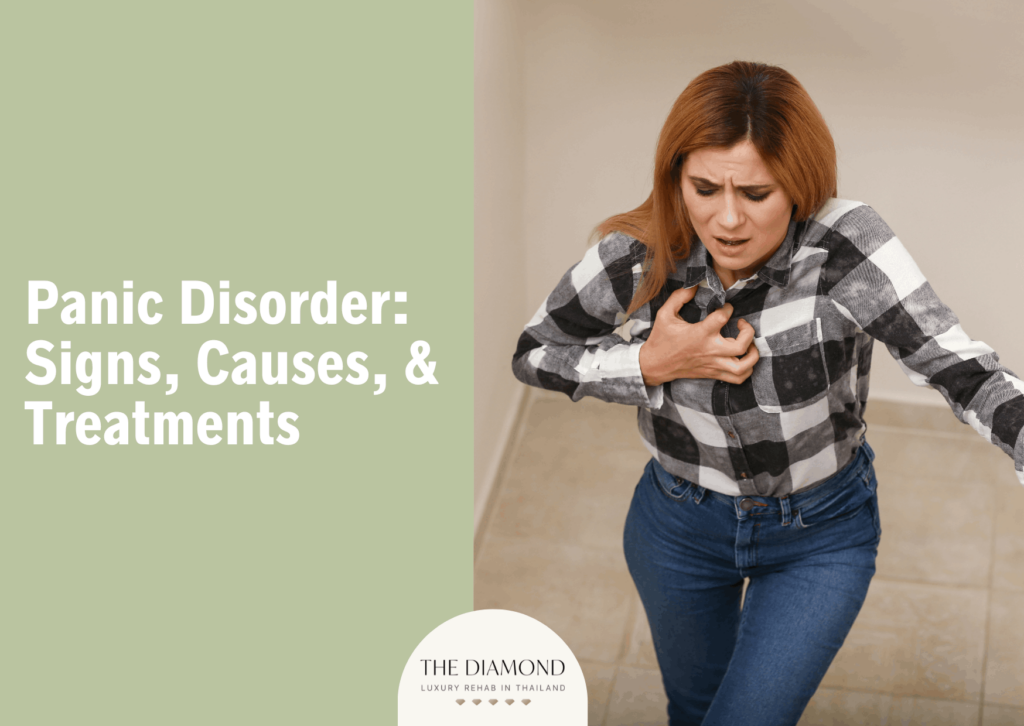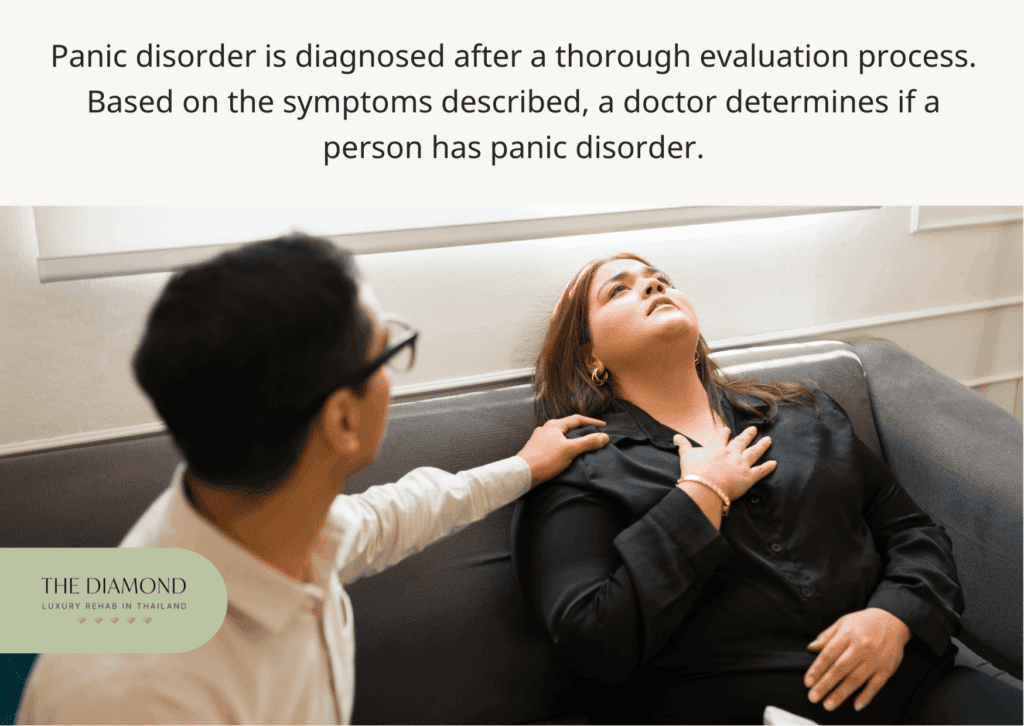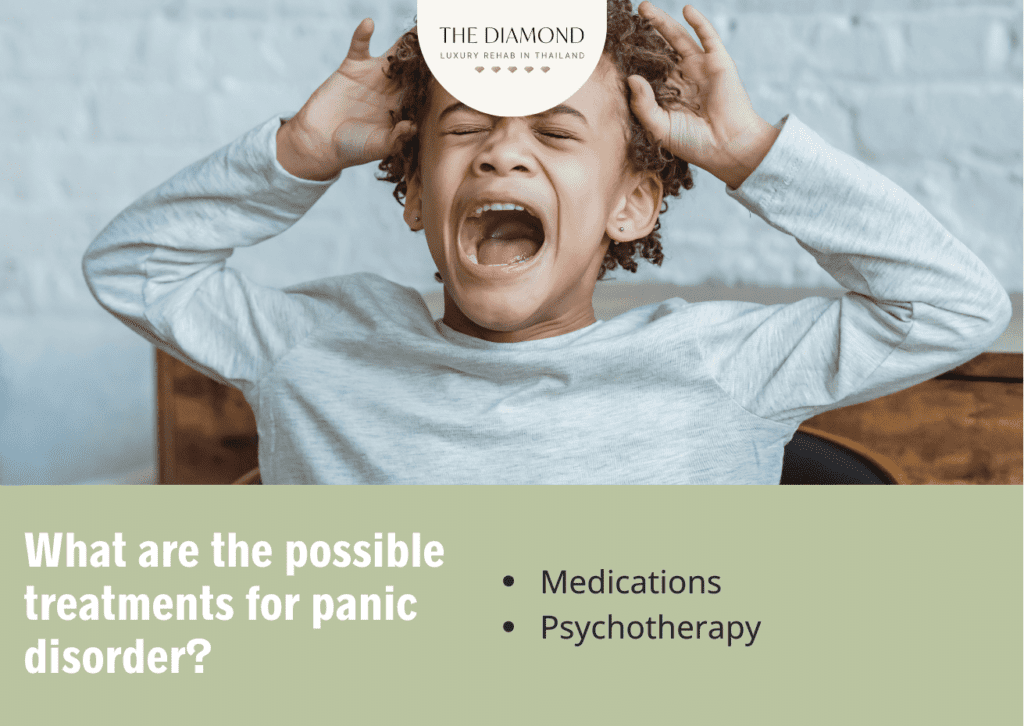Panic disorder: signs, causes, and treatment

Panic disorder is a condition where a person experiences recurrent, sudden panic attacks. It is classified as a type of anxiety disorder, and it has a major impact on a person’s quality of life.
Signs of panic disorder include overwhelming anxiety and fear, impending doom, loss of control, avoidance of places where panic attacks have occurred in the past, and constant worry about future panic attacks. Besides these, a person with panic disorder experiences physical symptoms such as shaking or tremors, chest pain, pounding heart rate, sweating, chills, difficulty breathing, and weakness.
The causes of panic disorder are genetics or heredity, trauma, changes in the function of some brain areas, and a person’s temperament. A combination of different factors lead to the development of panic disorder.
Treatment of panic disorder focuses on psychotherapy and medications, usually combined. The first-line treatment approach is psychotherapy i.e., cognitive-behavioral therapy. During therapy sessions, patients learn to identify and cope with the triggers of their panic attacks. The role of medications is to reduce the severity of symptoms that people experience.
What is panic disorder?
Panic disorder is a type of anxiety disorder indicated by sudden attacks of fear and panic. The Diagnostic and Statistical Manual of Mental Disorders, fifth edition (DSM-5) by the American Psychiatric Association defines panic disorder as an abrupt surge of intense fear or discomfort that reaches a peak within minutes. It’s been in the DSM since the third edition (DSM-3), released back in 1980.
Panic attacks are a frightening experience primarily because a person feels they’re losing control. Numerous people experience panic attacks, but not all of them have panic disorders. In people with this disorder, panic attacks occur frequently, and a person is constantly worried about them happening again.
Late teens or early adulthood is when panic disorder generally starts. It is an overreaction to the body’s natural survival instincts and behaviors. Most people get better with proper treatment for their panic attacks.
What are the signs of panic disorder?
Signs of panic disorder revolve around intense anxiety and physical sensations of fear. One way to determine the signs of a panic disorder is to observe how they occur. They usually appear without warning. A person with panic disorder tends to have multiple panic attacks and is constantly worried about having another. The symptoms usually go away within a few minutes. Once they go away, the affected individual feels fatigued and worn out. The most common signs of panic disorder are listed below:
- Sense of impending doom or danger
- Pounding, rapid heart rate
- Fear of loss of control/fear of death
- Intense worry about the next panic attack and when it’s going to happen
- Sweating
- Avoidance of places where previous panic attacks have occurred
- Shaking or trembling
- Sense of choking or tightness in the throat
- Shortness of breath
- Overwhelming anxiety and fear
- Nausea
- Abdominal pain
- Hot flashes or chills
- Dizziness or lightheadedness
- Weakness
- Chest pain
- Feeling of detachment or unreality
- Tingling sensation or numbness
What are the causes of panic disorder?

The causes of panic disorder are still relatively unclear, but several factors are possibly involved. The potential causes of panic disorder are listed below:
- Genetics: Even though more research is necessary about this subject, current evidence shows genes are involved in the development of panic disorder. For instance, a 2018 study by Eun Jeong Kim and Yong-Ku Kim published in AIMS Genetics stated that twin, family, and adoption studies, have suggested that panic disorder has a strong genetic component. This suggests that relatives of those who have the disorder are more likely to have PD than the general population.
- Trauma or major stress: Experiencing or witnessing a traumatic event or intense stress paves the way for frequent panic attacks and full-blown panic disorder due to the inability to cope with trauma in a healthier manner. More precisely, a person’s environment and life experiences play a role in the development of this condition.
- Brain function changes: Certain areas of the brain become hyperactive during panic attacks, and these changes contribute to panic disorder. This is particularly the case with the amygdala, the fear center of the brain. In other words, panic disorder has a neurological background. The changed activity in the amygdala and other areas, such as the temporal lobe, leads to panic disorder in affected people.
- Temperament: Certain individuals are more sensitive to stress and have a temperament that is prone to negative emotions. This kind of temperament is one of the potential causes of panic disorder.
What are the possible effects of panic disorder?
Possible effects of panic disorder are either short- or long-term, but they are more pronounced when the condition is not managed properly.
Short-term effects of panic disorder are mainly physical and revolve around higher blood pressure, sweating, shaking, heart palpitations, discomfort, and headache. A person additionally feels like they have no control over the specific situation and expect the worst to happen.
Long-term effects affect physical and psychological well-being as well as social functioning. These include loss of social support, social withdrawal, poor work performance, higher risk of disability, and suicidal thoughts and tendencies.
Other long-term effects of panic disorder include a higher risk of specific phobias, depression, anxiety, financial problems, substance abuse, and problems with health.
How does panic disorder affect quality of life?

Panic disorder affects quality of life in various ways. The symptoms tend to be so severe that a person misses school or work and falls behind due to low productivity. In order to manage their condition, people with this disorder engage in multiple doctor visits. This takes a major toll on their everyday life and responsibilities.
Avoidance of situations where people experience panic attacks is a hallmark symptom of this disorder. This leads to people avoiding important social events and gatherings out of fear of experiencing another panic attack. Social isolation ensues as well as problems with family, friends, and coworkers.
The impact on life is particularly severe in people who have panic disorder in addition to agoraphobia. Several people with panic disorder aren’t aware their symptoms are manageable.
They tend to believe no treatment is going to help them and are, therefore, reluctant to seek help. Not just that, but they don’t discuss the symptoms with their family, friends, and doctors even. This leads to suffering in silence, which further affects their quality of life.
How common is panic disorder?
Panic disorder is not uncommon. According to a publication from the National Institute of Mental Health titled, “Panic Disorder” set to expire in June 2024, between 2001 and 2003, the prevalence of panic disorder among U.S. adults in the previous year was 2.7%. The disorder is more common in women than men, with a prevalence of 3.8% and 1.6%, respectively.
The same happens in female adolescents; they are more likely to have panic disorders than males. The prevalence of panic disorder in adolescent females is 2.6% as opposed to 2.0% prevalence in males.
The same report showed that around 4.7% of adults in the United States have a panic disorder at a certain point in their lifetime. Of adults with panic disorder, there were about 44.8% with major impairment, 29.5% with moderate impairment, and 25.7% with mild impairment.
How is panic disorder diagnosed?

Panic disorder is diagnosed after a thorough evaluation process. Based on the symptoms described, a doctor determines if a person has panic disorder.
In order to diagnose the condition, they need to eliminate other potential causes of the symptoms. For that reason, a patient needs a physical exam. A doctor is likely to order lab tests to rule out other health problems.
Once these tests show a person doesn’t have a physical condition that possibly induces their symptoms, a healthcare provider refers them to a psychiatrist. The psychiatric evaluation involves talking about symptoms, stressful situations, fears, and concerns, as well as family history.
It’s important to keep in mind that not everyone who experiences panic attacks has panic disorder. The psychiatric assessment gives a psychiatrist a detailed insight into the intensity and duration of symptoms. In addition, it provides other information important for diagnostic purposes.
The psychiatrist is going to refer to DSM-5 to see whether the patient’s symptoms meet diagnostic criteria before they diagnose panic disorder. In order to be diagnosed with panic disorder, a person must be experiencing unexpected and recurrent panic attacks.
A person generally has panic disorder if they have experienced four or more panic attacks and if they live in constant fear of experiencing another one, according to an article titled, “Panic Disorder” from Johns Hopkins Medicine. They need to experience four or more symptoms of panic disorder as well.
How to prevent having a panic disorder?
The ways to prevent having a panic disorder encompass a range of tactics and lifestyle modifications aimed at diminishing the likelihood of developing panic disorder or effectively managing symptoms in those who are susceptible to or are experiencing panic attacks. The ways on how to prevent having a panic disorder are listed below:
- Identify triggers that lead to panic attacks in order to learn to manage them properly (this is usually done during therapy)
- Reduce caffeine intake
- Manage stress
- Eat a healthy, well-balanced diet
- Practice deep breathing
- Exercise regularly
- Consult a doctor about over-the-counter medications and herbal supplements that promote calmness and reduce anxiety
- Practice mindfulness meditation
- Adhere to the panic disorder treatment
- Get enough sleep
- Find a relaxing hobby
- Socialize
What are the possible treatments for panic disorder?

Possible treatments for panic disorder depend on the severity of the symptoms and how they affect a person. The possible treatments for panic disorder are listed below:
- Medications
- Psychotherapy
Medications
In the context of treating panic disorder, medications involve pharmaceutical interventions prescribed by healthcare professionals to alleviate symptoms and manage the condition. The main purpose of medications is to lower the severity of symptoms and aid the management of other problems, such as depression.
The healthcare professional prescribes the most suitable medications based on the patient’s condition. These usually include benzodiazepines, selective serotonin reuptake inhibitors (SSRIs), and serotonin and norepinephrine reuptake inhibitors (SNRIs).
Benzodiazepines as central nervous system depressants are a short-term pharmacotherapy approach because they are habit-forming, as per a 2018 article titled, “Panic attacks and panic disorder” from Mayo Clinic. They are effective in quickly reducing symptoms of panic attacks, though.
Antidepressants help with depression and symptoms of panic disorder. They’re not fast-acting, meaning it takes a few weeks to experience the effects.
Occasionally, a healthcare provider prescribes beta-blockers to patients with panic disorder. Beta-blockers address certain physical symptoms of panic disorder, such as sweating, tremors, and rapid heart rate.
If, by any chance, a specific medication doesn’t work for a patient, the doctor is likely to recommend another option or combine certain medications to increase their effectiveness.
Psychotherapy
Psychotherapy is the first line of treatment for panic disorder. The main goal is to help a patient understand their panic attacks, identify the trigger, and learn to cope with them.
The most common approach is cognitive behavioral therapy (CBT), which helps patients learn through their experience that panic symptoms aren’t dangerous. The main premise of CBT is that irrational or negative thoughts or beliefs lead to negative emotions and behaviors. Identifying these thoughts or triggers helps improve emotions and leads to more positive behavior patterns.
During CBT sessions, the therapist helps a patient gradually re-create symptoms of a panic attack in a safe manner. Just like in panic disorder, these attacks are repetitive. The goal is to achieve the point where the physical sensations of a panic attack don’t seem threatening anymore. That is when the attacks start resolving.
The number of CBT sessions varies from one patient to another, but a 2003 paper by Nadine Recker Rayburn and Michael W. Otto published in CNS Spectrums reported that 12 to 15 sessions are usually enough.
A study by Manfro et al., published in the October 2008 issue of the Brazilian Journal of Psychiatry concluded that CBT, whether administered alone or in a group setting, is a recommended initial treatment for panic disorder. The therapy technique can additionally be recommended as a further course of action for patients who have not shown improvement with previous treatments.
The process of CBT includes recognizing and replacing negative thoughts, followed by skill-building and behavioral changes. Patients receive homework for practicing skills they learned during the session.


